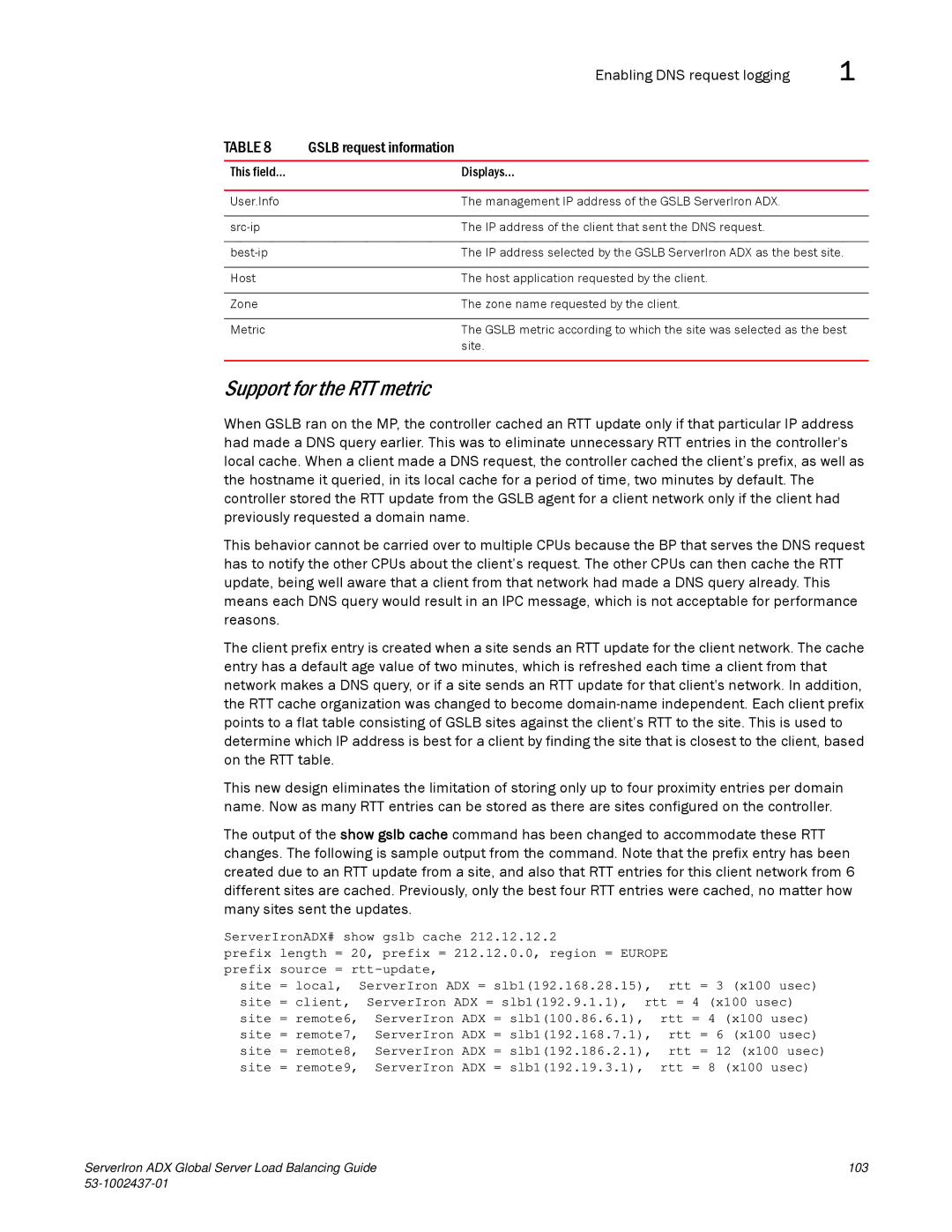| Enabling DNS request logging | 1 |
TABLE 8 | GSLB request information |
|
|
|
|
This field... | Displays... |
|
|
|
|
User.Info | The management IP address of the GSLB ServerIron ADX. |
|
|
|
|
The IP address of the client that sent the DNS request. |
| |
|
| |
The IP address selected by the GSLB ServerIron ADX as the best site. | ||
|
|
|
Host | The host application requested by the client. |
|
|
|
|
Zone | The zone name requested by the client. |
|
|
| |
Metric | The GSLB metric according to which the site was selected as the best | |
| site. |
|
|
|
|
Support for the RTT metric
When GSLB ran on the MP, the controller cached an RTT update only if that particular IP address had made a DNS query earlier. This was to eliminate unnecessary RTT entries in the controller's local cache. When a client made a DNS request, the controller cached the client’s prefix, as well as the hostname it queried, in its local cache for a period of time, two minutes by default. The controller stored the RTT update from the GSLB agent for a client network only if the client had previously requested a domain name.
This behavior cannot be carried over to multiple CPUs because the BP that serves the DNS request has to notify the other CPUs about the client’s request. The other CPUs can then cache the RTT update, being well aware that a client from that network had made a DNS query already. This means each DNS query would result in an IPC message, which is not acceptable for performance reasons.
The client prefix entry is created when a site sends an RTT update for the client network. The cache entry has a default age value of two minutes, which is refreshed each time a client from that network makes a DNS query, or if a site sends an RTT update for that client's network. In addition, the RTT cache organization was changed to become
This new design eliminates the limitation of storing only up to four proximity entries per domain name. Now as many RTT entries can be stored as there are sites configured on the controller.
The output of the show gslb cache command has been changed to accommodate these RTT changes. The following is sample output from the command. Note that the prefix entry has been created due to an RTT update from a site, and also that RTT entries for this client network from 6 different sites are cached. Previously, only the best four RTT entries were cached, no matter how many sites sent the updates.
ServerIronADX# show gslb cache 212.12.12.2 |
| |||
prefix | length = 20, prefix = 212.12.0.0, region = EUROPE | |||
prefix | source = | slb1(192.168.28.15), | rtt = 3 (x100 usec) | |
site | = local, | ServerIron ADX = | ||
site | = client, | ServerIron ADX = slb1(192.9.1.1), rtt = 4 (x100 usec) | ||
site | = remote6, | ServerIron ADX | = slb1(100.86.6.1), | rtt = 4 (x100 usec) |
site | = remote7, | ServerIron ADX | = slb1(192.168.7.1), | rtt = 6 (x100 usec) |
site | = remote8, | ServerIron ADX | = slb1(192.186.2.1), | rtt = 12 (x100 usec) |
site | = remote9, | ServerIron ADX | = slb1(192.19.3.1), | rtt = 8 (x100 usec) |
ServerIron ADX Global Server Load Balancing Guide | 103 |
|
